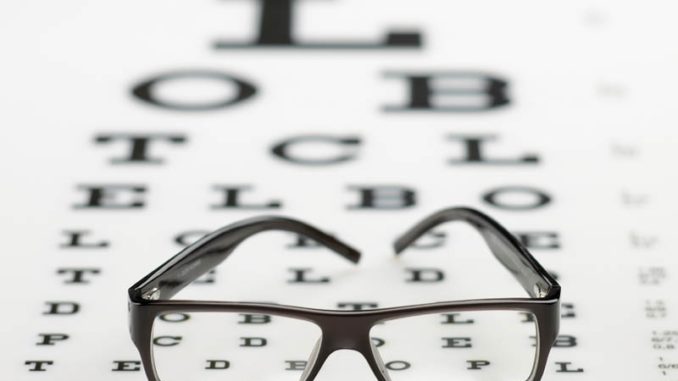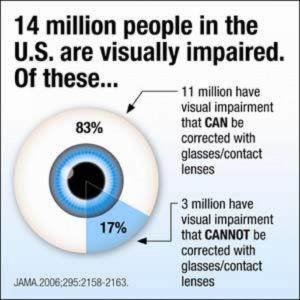
Table of Contents
What is Vision Impairment & Eye Care?
- Vision impairment refers to the discomfort or inability to see comfortably in day-to-day life.
- Vision impairment is any degree of interference in a person’s ability to see comfortably without the use of any devices or spectacles.
- Vision impairment also includes poor vision and blindness.
- Eye care simply refers to care and treatment of eyes.
- Eye care refers taking good care of the eye so that vision impairment can be prevented, minimized or reduced.
- Eye care is the provision of adequate, inexpensive, and easily accessible treatment that fully and expertly addresses patients’ eye care needs.
- Eye care focuses on ensuring better eye health and vision of an individual.
- Eye problems are remarkably prevalent. Anyone who lives long enough will eventually get at least one eye problem.
- Reduced or missing eyesight can have long-term economic and personal impacts in the absence of prompt detection.
- Due to fewer options to acquire the most essential eye care treatments, the burden of visual impairment might be considerably larger in low- and middle-income settings.
Classification of Vision Impairment
- The International Classification of Diseases 11 (2018) classifies vision impairment into two groups, distance and near presenting vision impairment.
- Distance vision impairment:
- Mild – visual acuity worse than 6/12 to 6/18
- Moderate – visual acuity worse than 6/18 to 6/60
- Severe – visual acuity worse than 6/60 to 3/60
- Blindness – visual acuity worse than 3/60
- Near vision impairment:
- Near visual acuity worse than N6 or M.08 at 40cm.
Key Facts of Vision Impairment
- More than 250 million individuals worldwide suffer from

Source: https://www.nih.gov/news-events/news-releases/study-finds-most-americans-have-good-vision-14-million-are-visually-impaired vision impairment (VI), including blindness, with 81% of those afflicted being 50 or older and 90% residing in low- and middle-income nations.
- The major causes of vision loss and blindness are cataracts and untreated refractive faults.
- The majority of those who are blind or have visual problems are over 50; however vision loss can afflict anyone at any age.
- Infectious and neonatal illnesses are no longer the main causes of VI globally; instead, age-related ocular disorders dominate.
- At least 2.2 billion people worldwide suffer from a near- or distant vision impairment.
- Nearly half of these cases, or at least 1 billion, involved visual impairment that either might have been prevented or is still unaddressed.
Causes of Vision Impairment
The causes of vision impairment varies between the countries and regions depending on the availability of eye care services, affordability of the people and eye care literacy. However, some of the major causes of vision impairment are:
- Age-related macular degeneration
- Cataract
- Diabetic retinopathy
- Glaucoma
- Uncorrected refractive errors
Symptoms of Vision Impairment
The symptoms that may indicate a visual impairment include the following; however symptoms vary depending on the source of the particular impairment.
- Seeing floating objects in field of view, such as lines or webs
- Observing light haloes or flashes
- Alteration of iris color
- Distorted vision
- Dual vision
- Sudden eye pain
- Recurring discomfort in the eye or nearby
- Unexpected change in eyesight
- Light sensitivity which is painful
- Daily tasks can also be hampered by visual impairments, such as more frequently bumping into items, difficulty ascending or descending stairs, or difficulty navigating uneven terrain.
- Finding it difficult to read, may have to hold the item closer to your face, or may find it tough to read in low light.
Diagnosis of Vision Impairment
Snellen test
- The visual acuity test is another name for the Snellen test.
- The Snellen’s chart is often used. It is located 6 meters away from the patient and has randomly shortened letters and numbers on it.
- The patient is instructed to read the letters using both eyes simultaneously and individually.
Visual field test
- A person’s visual field is the area of their field of vision that they can view without moving their head or tilting it. This evaluates the eyes’ lateral vision.
Tonometry test
- This examination measures the fluid pressure inside the eye using specialist tools.
Ocular Motility Assessment
- This determines whether there are any eye movement issues, such as squinting, or other issues.
Other tests
- In order to determine if the signals from the eye are reaching the brain effectively, other tests, such as the visually evoked potential (VEP), electroretinogram (ERG), and electro-oculogram (EOG), may be done.
Importance of Vision Impairment
1. Reducing the risk of certain diseases
- Regular eye exams and optimal eye care help people lower their chance of contracting numerous diseases.
2. Reduced risk of eye injury
- Almost 90% of eye injuries can be avoided by using the proper eyewear.
- Having the proper eyewear can help see clearly and prevent any ocular or other physical harm.
3. Early detection of any changes in eyesight:
- For the diagnosis and treatment of any vision abnormalities, routine eye care is crucial.
- Additionally, vision changes can be a sign that it’s time to update the prescription or switch out the glasses.
4. Diagnosis of underlying medical condition:
- The earliest stage of some underlying medical conditions affects the eyes. Diabetes and hypertension are two of these conditions.
- As a result, eye care aids in the early detection of such illnesses.
Ways to Reduce Vision Impairment/Care For Eye
- Avoid rubbing eyes as hands can be exposed to a lot dirt, dust and bacteria and can be transferred to eyes
- Practicing frequent hand washing to keep bacteria at bay and prevent from getting in eyes
- Protecting eyes from the sun by using sunglasses to reduce age related macular degeneration and cornea sunburn
- Sufficient fluid intake to keep body’s overall well being as well as eyes
- Smoking makes more susceptible to age-related macular degeneration and other eye conditions such as cataract. So it is best suggested to avoid smoking
- Vitamins C, A, and E, beta-carotene, lutein, omega-3 fatty acids, lycopene, and lutein are necessary to maintain the health of your eyes. Thus it is necessary to include a variety of foods that are high in those nutrients in your diet.
- Computer screens should be positioned an arm’s length away from the eyes and 20 degrees below eye level. By doing this, eye strain is prevented.
- Observing the 20-20-20 rule of looking away from computer every 20 minutes, fixing gaze on object 20 feet away, blinking 20 successive times, getting out of seat and taking 20 steps
- Getting enough sleep to recharge the eyes
- Wearing appropriate safety gear for different activities like swimming, gardening
Consequences of Vision Impairment

- Loss of vision can have an impact on one’s mobility, independence, and quality of life (QOL).
- A low quality of life and many detrimental health effects are frequently linked to vision impairment.
- With the outset of vision loss, QOL gradually declines; however, when measurements of visual field defects rise, QOL declines more abruptly.
- Patients who lose their vision struggle to work, take care of others, and engage in a variety of daily activities like reading, interacting with others, and engaging in hobbies.
- The essential self-care tasks of daily living are made more challenging by vision impairment, which also increases dependence.
- Vision is the main sense that a person with healthy eyesight uses to move around. Therefore, vision loss has a significant impact on mobility.
- Poor visual acuity is only one element of visual impairment that has been demonstrated to be linked to a higher risk of fracture.
- People who have lost their vision are more likely to sustain many forms of injuries. The relationship between vision loss and injuries caused by falls is the one that has the most conclusive evidence.
- Compared to older adults without visual impairment and older adults with other chronic diseases including hypertension and heart problems, older adults with vision impairment have much greater rates of anxiety and depression.
- According to a number of research, older persons with vision impairment experience cognitive impairment more frequently and at a faster rate than those without.
Treatment
Treatment options for visual impairments include:
- Optical devices
- Medications
- Surgical treatments like glaucoma surgery, cataract surgery or laser eye surgery
WHO Response
- Monitoring the global goals for integrated, patient-centered eye care for 2030 in collaboration with Member States and other field partners.
- Celebration of World Sight Day and promoting as a yearly advocacy occasion.
- Promoting the use of a number of technical technologies to support the integration of eye care into health systems:
- Eye care in health systems: A practical guide assisting Member States with the planning and execution of the World report on vision’s recommendations in a practical, step-by-step manner.
- Eye Care Competency Framework and Bundle of Eye Care Interventions (ECCF)
- Myopia mobile health toolbox
- The creation and use of instruments to assist nations in evaluating the provision of eye care services, such as:
- Eye care services assessment tool
- Tool for Assessment of Diabetes and Diabetic Retinopathy Services
- Tool for the Assessment of Glaucoma Services
References and For More Information
https://www.who.int/health-topics/blindness-and-vision-loss#tab=tab_1
https://www.aao.org/clinical-statement/definition-of-primary-eye-care–policy-statement
https://eyecarefoundation.eu/visual-impairment/
https://www.ncbi.nlm.nih.gov/pmc/articles/PMC6440432/
https://www.who.int/news-room/fact-sheets/detail/blindness-and-visual-impairment
https://kidshealth.org/en/teens/visual-impairment.html
https://www.sciencedirect.com/topics/nursing-and-health-professions/visual-impairment
https://study.com/academy/lesson/what-is-vision-impairment-definition-causes-symptoms.html